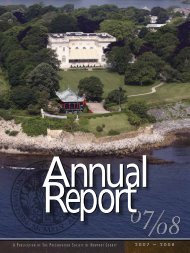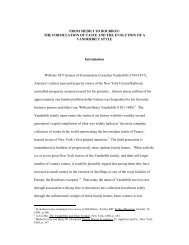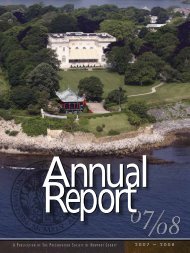The French Connection: Developing a Conservation Treatment Plan ...
The French Connection: Developing a Conservation Treatment Plan ...
The French Connection: Developing a Conservation Treatment Plan ...
You also want an ePaper? Increase the reach of your titles
YUMPU automatically turns print PDFs into web optimized ePapers that Google loves.
<strong>Treatment</strong> philosophy<br />
<strong>The</strong> panels have a history, including restoration and repair, before Allard acquired them, but it will be<br />
his installation of the antique panels and the fabrication/supply of the fourth panel and overdoors that<br />
will be the targeted period of interpretation – they are an ensemble. All restorations up to that point will<br />
be preserved as artifacts of their complicated lives. <strong>The</strong>re are some beautifully bright and fine repairs to<br />
the old panels: bright gold and an intense red ground next to aged gold and darkened vermillion. It is a<br />
fine contrast that will be respected. <strong>The</strong> panels acquire and deliver value through their authenticity as<br />
original artifacts in the context of Allard and the interior architecture of <strong>The</strong> Elms. In that spirit, the<br />
treatment will be in the western conservation tradition, using adhesives, fills, colorants and coatings that<br />
are familiar and that we know are stable and re-treatable. <strong>The</strong> condition of the fissured surface, the<br />
translucency of the black lacquer caused by light, the discoloration of the water-damaged lacquer, and<br />
an inability to set down all cracks or tenting will keep the treatment from returning the surface to its predamaged<br />
condition. Shrinkage cracks and the prospect of continuing wood movement will need to be<br />
addressed.<br />
<strong>Treatment</strong> plan for the panels<br />
At present, the treatment plan for the three antique panels entails securing the lifting lacquer, removing<br />
the unsightly repairs that post-date the installation of the panels at the Elms, and removing the more<br />
recent varnish applied before those repairs but after all of the other repairs and changes. <strong>The</strong> Allard<br />
panel is in excellent condition and merely requires the removal of a thick coating of wax.<br />
Thoughts on adhesives<br />
A variety of adhesives have been used to reattach lacquer. For thin flakes of decoration or thin layers of<br />
lacquer, some thermoplastics and synthetics have been used with success. However, for reattaching the<br />
tenting areas of thicker lacquer, many have been found to be too weak or too flexible to successfully set<br />
down this recalcitrant material. Practitioners have found success with protein adhesives and certain<br />
synthetics [24], protein-synthetic-starch hybrids [25], and urushi itself [26].<br />
A successful adhesive should have enough adhesive strength, not deliver too much water to the area, and<br />
be re-treatable. <strong>The</strong> consultants involved in this project uniformly regarded cold fish glue as a good<br />
choice, and it was tested with success on the South panel. However, other practitioners have found it to<br />
be wanting [27]. Other high strength protein glues have also been used, such as isinglass, rabbitskin glue<br />
and hide glue.<br />
So called “high strength” protein glues gain the name as much for a particular behavior as for any<br />
increase in strength. That behavior is the ability for small amounts of solid glue to gel/thicken larger<br />
amounts of water. For instance, the high gram-strength protein glues, such as Bloom Gram #315 hide<br />
glue, gelatin, rabbitskin glue, and perhaps the fish glues gel a high percentage of water relative to the<br />
solids component. (#315 hide glue at a useable viscosity for slow assemblies is used at 1 part dry glue to<br />
2.25 parts water). For glue with a useful consistency, this results in a higher water content and, more<br />
12





